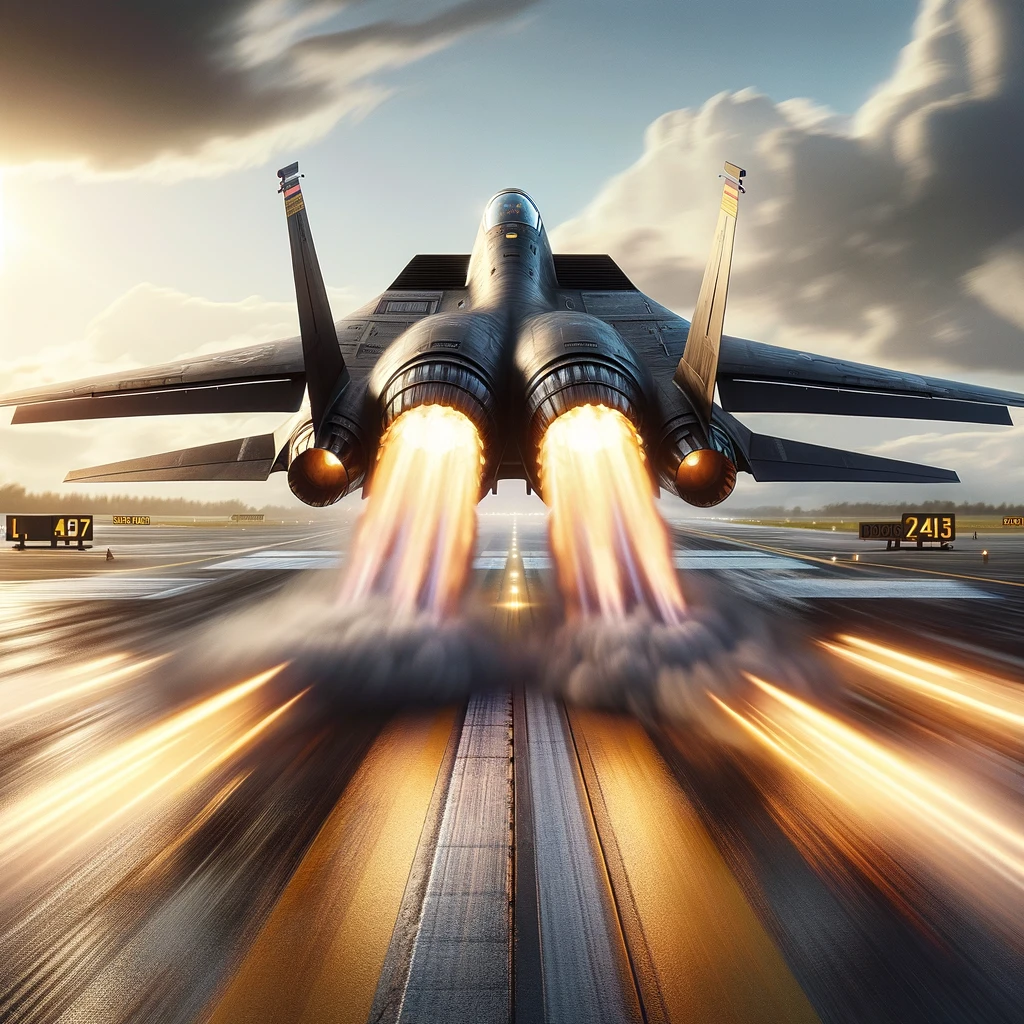In 1964, the first successful flight of the F-111A Prototype Version was taken, & with this, a Revolutionary Milestone was made in Aviation History. Throughout its service period, the F-111 Aardvark is one of the few aircraft that have had a lot of controversy and faced many development challenges. Still, no other airplane has been as versatile and practical as the F-111 Aardvark.
As part of the U.S. Air Force’s TFX fighter program, the F-111 was designed to meet both the USAF’s need for a deep penetration strike aircraft and the need for a new air-to-air combat fighter by the U.S. Navy. Because of this dual-service requirement, the design has become tremendously innovative but also controversial at the same time.
Development and Design of The F-111 Aardvark:
The program of the F-111 Aardvark development was complete with complicated technical advancements, including a variable geometry wing, with which the plane could move faster and lower to avoid enemy defenses. The most useful technology of that time, & the F-111 Aardvark proved to be fully capable of.
This Aircraft was Designed for a two-person crew – a pilot and a weapons officer/co-pilot – sitting next to each other in an ejectable capsule, also known as an escape pod.
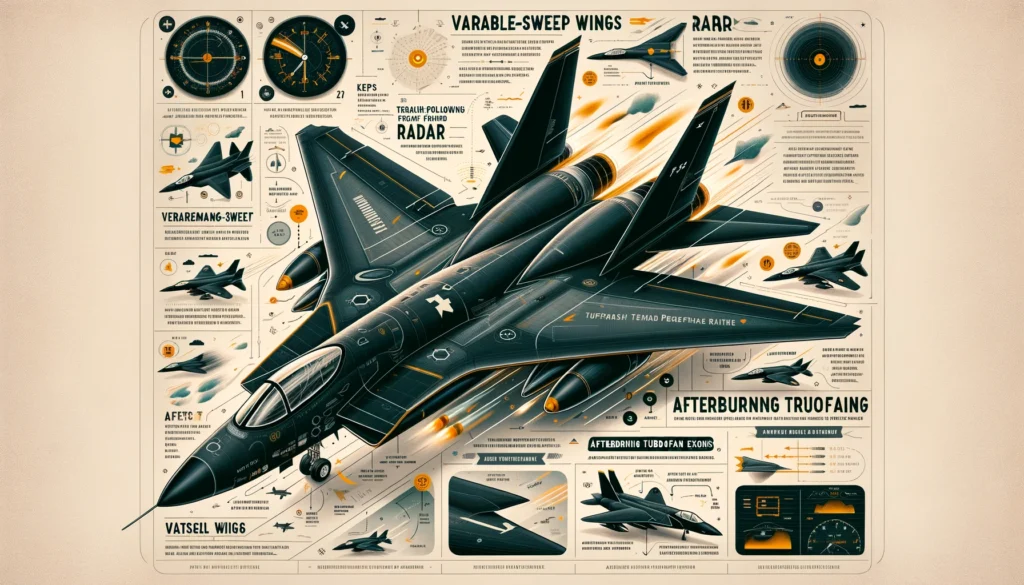
The road from the start of its construction till the operational stage has had significant technical setbacks and budget overflows, and it has brought fierce debates within (and outside) the Department of Defense to the point of split. However, the F-111 Aardvark, whose creation is a challenge, became a standard of innovation, introducing technologies that would become a standard of all modern combat aircraft.
Development Timeline
- 1950s Concepts: Initial ideas focused on a “Tactical Fighter Experimental” (TFX) program aimed at creating a versatile aircraft for various military branches.
- 22 December 1964: First flight of the F-111A prototype. Early testing highlighted issues with the wing box design and that resulted in several new redesigned versions.
- 1967: Resolution of initial technical problems, leading to the improved F-111E version, which resolved weight and performance issues.
Design Features
- Variable-Sweep Wings: It could fly at high speeds and alongside its capability at slow speeds, with these robust features helping interchange mission profiles.
- Terrain-Following Radar: At the low-level, high-speed flight that minimizes weather deflection and enhances bomb accuracy for aircrew survivability.
- Crew Ejection Capsule: A protective command in which the escape pod takes the role of saving the crew during an emergency, ultimately increasing the possibility of their survival.
- Wing Span: 63 feet at 16 degrees sweep and 32 feet at 72.5 degrees sweep, enabling adaptability from takeoff/landing to high-speed flight.
- Engines: Equipped with “2” Pratt & Whitney TF30 turbofans engine technology, each capable of producing up to 25,100 lb of thrust with afterburners, allowing for speeds over Mach 2.5. For an aircraft to fly supersonic, extreme power is supplied for its turbofan engines, proving its long-range strike capabilities throughout its service period.
- Avionics: Advanced for its time, including the AN/AVQ-26 Pave Tack pod installed in the later models for laser-guided bombing accuracy.
- Weapons Capacity: Could carry conventional bombs, nuclear weapons, and, later, precision-guided missiles, with a typical load of up to 31,500 pounds.
Operational History of F-111:
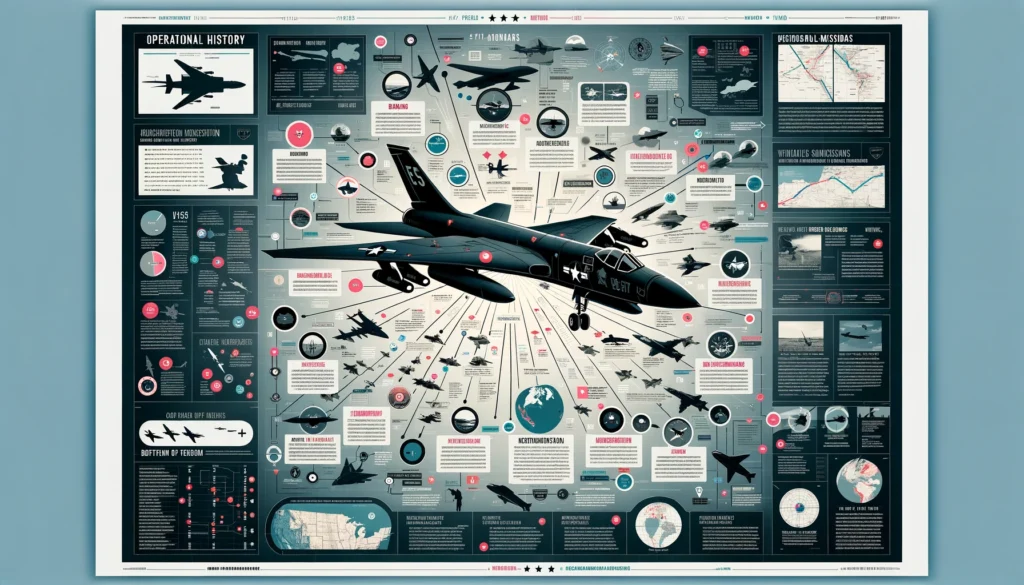
- Vietnam War (1968): Premature deployments of F-111s resulted in losing planes. Yet, after 1972, with the advanced models and their accuracy, the U.S. Airforce mastered the strategic bombing techniques.
- Cold War Era: The advancement in war technology by the USAF made F-111 a success for the strategic bomber fleet. Its internal parts were modified to play the role of EW, strategic bombing, etc.
- European NATO Base: The F111s were then stationed in the UK as part of the US Air Force’s commitment to NATO as a strategic deterrent during the Cold War.
- Operation Desert Storm (1991): F-111Fs made an invaluable contribution to the Gulf War, introducing new Pave Tack pods for pinpoint strikes that, in return, brought about unprecedented precision and utility.
- Operation El Dorado Canyon (1986): It was seen to execute critical missions of the strategic distant bombing of Libya, where it had a chance to witness its ability to struggle with the arbitrariness of the precision of bombing.
- Final Missions: On the 27 of April 1996, the final mission of the F-111F variant was accomplished. After that day the F-15E Strike Eagle and F-16 Fighting Falcon aircraft were introduced to replace the F-111F model, and with this, a new Aircraft era got started.
- Retirement: In 1998, F-111 was finally declared to be withdrawn & grounded from service by the U.S. Air Force. The Australian Air Force, nevertheless, utilized it until 2010.
World’s Fastest Military Aircraft: Experience the Thrill of Speed Now!
F-111 Comparison with its updated versions (F-15E Strike Eagle & F-16 Fighting Falcon Aircraft):
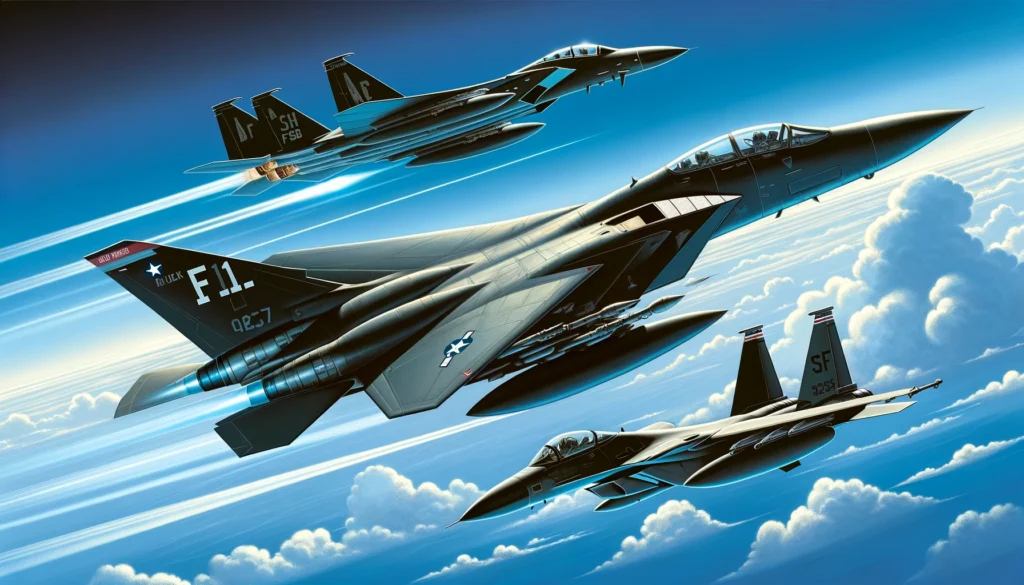
| Feature | F-111 | F-15E Strike Eagle | F-16 Fighting Falcon |
| Introduction | 1967 | 1989 | 1978 |
| Role | Fighter-bomber | Multirole fighter+bomber | Multirole fighter |
| Manufacturer | General Dynamics | Collaboration of McDonnell Douglas & Boeing Company | Collaboration of General Dynamics & Lockheed Martin |
| Maximum Speed | Top speed of Mach 2.5 (about 1,650 miles per hour) | Top speed of Mach 2.5 (about 1,650 miles per hour) | Mach 2+ (1,500 mph) |
| Crew | 2 (pilot, weapons system officer) | 2 (pilot, weapon systems officer) | 1 (pilot) |
| Length | 73 ft 6 in (22.4 m) | 63 ft 9 in (19.43 m) | 49 ft 5 in (15.06 m) |
| Wingspan | 63 ft (19.2 m) | 42 ft 10 in (13.05 m) | 32 ft 8 in (9.96 m) |
| Maximum Takeoff Weight | 100,000 lb (45,360 kg) | 81,000 lb (36,700 kg) | 42,300 lb (19,200 kg) |
| Engine | Pratt & Whitney TF30 turbofans | Pratt & Whitney F100-PW-220 | General Electric F110-GE-100 |
| Armament | Variable, including bombs, missiles, guns | AIM-120 AMRAAM, AIM-9 Sidewinder, JDAM, bombs, etc. | AIM-120 AMRAAM, AIM-9 Sidewinder, JDAM, bombs, etc. |
| Combat Radius | 1,330 mi (2,140 km) | 790 mi (1,270 km) | 340 mi (550 km) |
| Avionics | AN/APQ-113 radar | AN/APG-70 radar | AN/APG-68 radar |
| Notable Features | Variable sweep wings, terrain-following radar | Long-range strike capability, terrain-following radar | Relatively small size, agile maneuverability, ease of maintenance |
| Operational Status | Retired | Active service | Active service |
| Range | 3,400 mi (5,472 km) | 2,400 mi (3,860 km) | 2,620 mi (4,220 km) |
| Notable Records | Set several speed and altitude records | Holds multiple world records for speed and altitude in its weight class | Holds numerous world records for speed, altitude, and time-to-climb |
F-111 Technical Specifications in Detail:
The F-111 Aardvark is one of the few jets that stand out for eradicating barriers to the aviation industry. This multi-purpose aircraft had high-tech facilities and features that the planes of those days did not have. The F-111 contributed notably because of its unique capabilities, which branded it as a force to be reckoned with across multiple mission scenarios.
F-111 Aardvark Variable Geometry Wings:
By swinging its wings from 16 to 72.5 degrees, the F-111 was endowed with one of its most impressive technological inventions, with a variable-sweep wing geometry feature. This design was an innovation that made the plane better aerodynamically and able to optimize the performance at High altitudes, with configurations of speed and agility. That was the unmatched advantage of such aircraft over the other planes because of this particular feature.
F-111 Aardvark Turbo Engines:
The F-111 was armed with a two-engine set comprising TF-30-P-100 Pratt & Whitney turbofan units, giving it thrust in hitherto unknown levels. That, therefore, was superb in making the pilot cover long ranges for missions and fast inhaul speed. The engines were the primary devices that allowed the planes to carry out the typical flight campaigns without refueling in the air on shorter trips.
F-111 Aardvark Record-Breaking Speed and Range:
Likewise, the speed and the range of the F-111 were why the aircraft was awe-inspiring; it c, and reached the maximum speed of Mach 2.5 at a high altitude. Furthermore, the plane had a ferry range of 4,000 miles (6,400 kilometers) when equipped with external fuel tanks. By doing so, it could conduct deep penetration strikes without needing in-flight refueling on shorter missions. That could also help avoid the formation of waves by flying a flat traverse. The F-111 was a high-performing aircraft that could merely conduct air strikes.
F-111 Aardvark Advance Avionics:
Another vital point for F-111 was the presence of state-of-the-art avionics. They contained a terrain-following radar. Low-level flying, made possible by the plane’s radar-evading ability, allowed it to fly during all types of weather, making it difficult for enemy aircraft radar to detect. Consequently, this fact had its role as a tool to perform selective bombing and surveillance. The aircraft’s state-of-the-art electronics gear it into a multi-purpose and multi-role competent element in many battle scenarios.
F-111 Aardvark Heavy Armament:
Carrying a huge range of weapons, the F-111 was designed to meet different mission requirements. The plane could act as a platform for many different armaments such as Bombs, Nukes of Air-Air Combat Missiles, and, later on, Guided weapons. It was the adaptive characteristic of the mangonel that gave it an edge in many scenarios of use in the field of combat. F-111 was a “Carson” of airplanes that could go for all options.
F-111 Aardvark Crew and Ejection System:
While developing the F111, they go for a two-seat, side-by-side configuration design, with a pilot and weapons systems officer. This design facilitated efficient communication and coordination between the crew and made provisions for sleep periodization, which mitigated di-compensation problems. It also got a new escape capsule system whereby the crew members could survive even when hit by an enemy rocket, by just ejecting the capsule. The F-111 was designed to ensure its crew members’ safety, no matter the situation.
F-111 Aardvark Operational Ceiling and Weight:
The F-111’s peak ceiling was well over 60,000 feet (18,300 meters), and that was the highest altitude of that time. Besides its capacity to operate at high altitudes, some models were heavier than others.
The empty weight of a base model was 21,319 kilograms (about 47,000 pounds), and the maximum takeoff weight of approximately one hundred thousand pounds (45,360 kilograms), more than double of F-111’s weight. In sum, the F-111 was a spectacular plane that dealt with far-advanced technologies.
| Specification | Detail |
| Advance Wing Design | Variable Geometry Wings; sweep range from 16° to 72.5° |
| Turbo Engines | 2 × Pratt & Whitney TF30-P-100 turbofan engines |
| Record Breaking Speed | Mach 2.5 at high altitude |
| Extended Range | Over 4,000 miles (6,400 kilometers) with external tanks |
| Advance Avionics | Advanced terrain-following radar |
| Heavy Armament | Capable of carrying nuclear and conventional bombs, precision-guided munitions |
| Cabin & Crew | 2 (Pilot and Weapons Systems Officer), side-by-side seating |
| Safer Ejection System | Enclosed escape capsule for crew safety |
| Operational Ceiling | Exceeding 60,000 feet (18,300 meters) |
| Super Weight Capacity | Empty: ~47,000 lbs (21,319 kg), Max Takeoff: ~100,000 lbs (45,360 kg) double of F-111 Aircraft’s weight |
F-111 Variants:
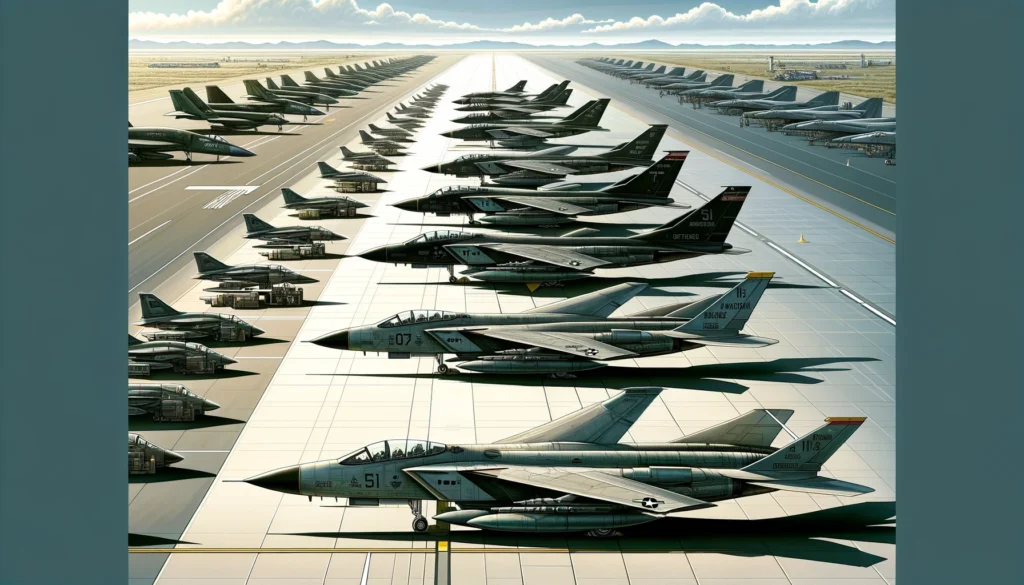
F-111A:
- Role: First airplane design for the USAF.
- Key Features: Packed with TF30-P-3 motors, max speed of Mach 2.3, and Mark I avionics, which is avionics that makes it possible to fly in the terrain.
- Production: 159 new units, including conversions to EF-111A Raven airplanes.
- Operational Use: Changed to electronic warfare purposes and presented to Australia as attritional replacements modified in the F-111C’s standard.
F-111B:
- Role: The U.S. Navy fleet air defense fighter which, in the end, turned out to be a nonstarter in the U.S. Navy.
- Key Features: Constructed for carriage-based flight and weighty, long-distance missiles.
- Outcome: Swapping places with F-14 Tomcat, which some changes introduced by F-111B.
F-111C:
- Role: Australian adaptation of the F-111, taking the best from the F-111A and F-111B versions.
- Key Features: Extended wings, upgraded landing gear, and aircraft digital avionics installations.
- Operational Use: Operated within the Royal Australian Air Force up until 2010.
F-111D:
- Role: Modernized version equipped with avionics and powerful engines.
- Challenges: Delays and operational problems, mostly exacerbated by the complex avionics systems.
F-111E:
- Role: Without a doubt, a preliminary version reunited the features of the F-111A and F-111D models.
- Operational Use: She served in the UK and was a crew member during the Gulf Crisis.
F-111F:
- Role: Revisioned new Model TAC refers to the updated computerized and turbo-engines.
- Key Features: Increased precision and armed with multiple guided munition options.
- Operational Use: Before changing the F-16 to this fighter aircraft, it was a crucial player in the Gulf War.
F-111K:
- Role: An alternate who would be for the Royal Air Force with the British but was scrapped.
- Outcome: This item was used for other variant models of F-111s.
FB-111A / F-111G:
- Role: The long-range bomber version with maximum load capacity.
- Operational Use: Transferred into F-111G mode for tactical uses and served until the early 1990s.
EF-111A Raven:
- Role: This is a smart-converted version of the bombing version of an F-111A.
- Operational Use: Offered tactical electronic jamming while deployed and retired in 1998.
Complete Details of F-111 All Manufactured Varients
| Variant | Designed For | Notable Features | Powerplant | Advanced Avionics and Systems | Historical Significance | Production and Modifications | Global Impact |
| F-111A | USAF Tactical Deep Strike | The first production variant, capable of Mach 2.3, equipped with variable-sweep wings for versatile flight profiles | Pratt & Whitney TF30-P-3, 18,500 lbs with afterburner | General Electric AN/APQ-113 attack radar, Texas Instruments AN/APQ-110 TFR, Litton AJQ-20 INS | Pioneered low-level penetration tactics in Vietnam, demonstrating the effectiveness of terrain-following technology | 159 produced; served as a base for the EF-111A Raven electronic warfare variant | Enhanced USAF’s strike capabilities during the Cold War, influencing subsequent tactical aircraft designs |
| F-111B | Naval Fleet Air Defense | Navy variant with long-range air-to-air missiles, canceled due to weight and agility issues | Pratt & Whitney TF30 (specific variant details not widely disclosed) | Designed for the AIM-54 Phoenix missile system, incorporated advanced naval radar systems | Development challenges contributed to the inception of the F-14 Tomcat | 7 prototypes; program cancelled | Influenced future naval air defense strategies, directly impacting the design of the F-14 Tomcat |
| F-111C | RAAF Strategic and Tactical Bombing | Combined F-111A’s airframe with F-111B’s longer wings, enhanced for Australian operational requirements | Pratt & Whitney TF30-P-3 | Similar to F-111A but included upgrades over its service life, notably the PAVE TACK system for precision targeting | Integral to RAAF’s long-range strike capability, it served until 2010 | 24 initially ordered; received additional modified F-111As from USAF stocks | Marked significant Australian defense capability, unique in non-US operation |
| F-111D | Enhanced USAF Tactical Strike | Featured an early version of a glass cockpit and improved avionics for greater accuracy and reliability | Pratt & Whitney TF30-P-9 with improved performance | Mark II avionics with integrated digital flight control systems, multi-function displays | Faced development issues but enhanced electronic warfare and strike operations | 96 delivered; experienced significant delays and enhancements to overcome initial issues | Advanced avionics integration in combat aircraft, setting a precedent for future developments |
| F-111E | Simplified Interim Variant | An interim solution combining the F-111A’s engines with the F-111D’s airframe modifications | Pratt & Whitney TF30-P-3 | Retained the F-111A’s simpler avionics but incorporated improvements from the F-111D, including weapon store management system upgrades | Deployed to the UK, saw action in Operation Desert Storm | 94 produced; focused on reliability and maintainability over the F-111D’s complexities | Demonstrated versatility and effectiveness of F-111 platform in coalition operations |
| F-111F | Precision Low-Level Strike (USAF TAC) | Most advanced variant, featuring powerful engines and avionics capable of delivering precision munitions | Pratt & Whitney TF30-P-100, 25,100 lbf with afterburner | Equipped with Pave Tack pod for laser-guided bomb targeting, Mark IIB avionics suite for enhanced targeting and navigation | Played a key role in the Gulf War, using precision weapons to achieve strategic objectives | 106 produced; last variant designed for the USAF | Showcased the apex of F-111 development, heavily influencing modern precision strike concepts |
| F-111K | Intended for UK RAF Strike Role | Was to be a blend of the F-111A and F-111C with specific modifications for the UK, including reconnaissance capabilities | Pratt & Whitney TF30 (with specific enhancements planned for RAF use) | Planned to include advanced British avionics and systems tailored to UK requirements | Cancellation impacted UK’s strategic air capabilities and led to alternative acquisitions | Order for 50 cancelled; none completed | Influenced international defense procurement strategies and highlighted challenges of cross-national defense projects |
| FB-111A / F-111G | Strategic Bombing / Tactical Use | Extended range for strategic missions, later adapted for tactical roles with conversion to F-111G | Pratt & Whitney TF30-P-7 for FB-111A; modifications in F-111G | Strategic Air Command (SAC) specific avionics for FB-111A, including enhanced navigation and targeting systems for nuclear and conventional payloads | Served as SAC’s interim bomber, transitioned to tactical roles reflecting strategic shifts in USAF | 76 as FB-111A; 34 converted to F-111G for tactical roles | Demonstrated adaptability of F-111 platform from strategic to tactical applications |
| EF-111A Raven | Electronic Warfare and Jamming | Converted F-111A for stand-off jamming, featured distinctive “canoe” housing electronic warfare equipment | Pratt & Whitney TF30-P-3 | Equipped with an extensive suite of electronic warfare systems for radar jamming and deception, replacing older EB-66 and EA-6A platforms | Critical asset in USAF’s electronic warfare capabilities, notably during Operation Desert Storm | 42 converted from F-111A; last to retire in 1998 | Enhanced coalition air operations by providing electronic protection for strike packages |
Become a Navy Pilot: Dream Bold, Soar With Valor Now!
Commonly Asked Questions about the F-111 Aircraft:
What is the F-111 aircraft?
The F-111 was a wild & multi-dimensional twin-engine supersonic fighter-bomber initially developed by General Dynamics for the USAF but later used by the RAAF. It was intended for ASW, strike, command and control, intelligence, and electronic combat.
When was the F-111 first introduced?
The F-111 debuted with the USAF in ’67 and later, in ’73, made an entry with the RAAF.
Was the F-111 a good plane or not?
The F-111 was a pioneering aircraft that was groundbreaking in its time. It boasted cutting-edge avionics and geometry wings, allowing the aircraft to be accurately guided at high speed. On the other hand, its flight record was a mixed bag, as it was confronted with various troubles like expensive of in-service support and launch incidents. Those features as possession, both of mission covering role as interdiction and reconnaissance, were questioned to be effective by experts and historians.
A-5 Vigilante vs.F-111: Which is better?
The way-back machine may be an excellent choice for those seeking the best samples. High-Speed A-5 Vigilante served the nation admirably and left a lasting legacy in the reconnaissance division. The F-111, though, had combined features such as the versatility and the ability to redefine the mission and preserve the current technology so that it would remain relevant as other types did. Ultimately, the “best” choice depends on the particular specifications for a mission and the period the aircraft is being evaluated.
What were some notable features of the F-111?
- Variable-sweep wings: The F-111, which belongs to the first generation of operational airplanes that incorporated the variable-sweep wing configuration, manages to change how the wing profile is set on the aircraft during flight at varying speeds and altitudes to improve performance.
- Terrain-following radar: This plane was endowed with a provision of terrain-following radar; therefore, it flew at low altitudes, just above the ground, closely following the terrain to evade enemy radar.
- All-weather capabilities: F-111 could execute all kinds of missions in all weather conditions during day or night.
What roles did the F-111 serve during its operational history?
The F-111 served in various roles, including
1. Strategic bombing
2. Tactical bombing
3. Electronic warfare
4. Reconnaissance
Why was the F-111 retired?
The F-111 was retired from service for several reasons:
- Aging airframes: It was not uncommon that some of the F-111 planes have been used for a long time, causing higher maintenance expenses and potential problems.
- Technological advancements: The F-111 aircraft, with new technologies and capabilities, started to gradually phase out older F-111 aircraft that did not fit in modern warfare scenarios anymore.
- Cost considerations: As the expenses associated with the F-111’s group movements and operations increased, the F-111 became economically ineffective compared to the newer and more efficient planes.
- Safety concerns: With the aircraft being of advanced age and increasingly concerned with structural integrity and the reliability of the systems being at the forefront, the inevitability took shape, and the decision to retire the fleet was made.
When was the F-111 officially retired from service?
The F-111 had its final flight with the RAAF in December 2010, concluding its service, which commenced back in the 1970s.
What aircraft replaced the F-111 in service?
In the United States, the F-111 was primarily made obsolete by the F-15E Strike Eagle and the F-16 Fighting Falcon. In Australia, the F/A-18F Super Hornet replaced the F-111, executing its former missions.
Phenom 300e Epic: Discover the Ultimate Flying Experience Now!
Some Final Thoughts: Sunset of F-111
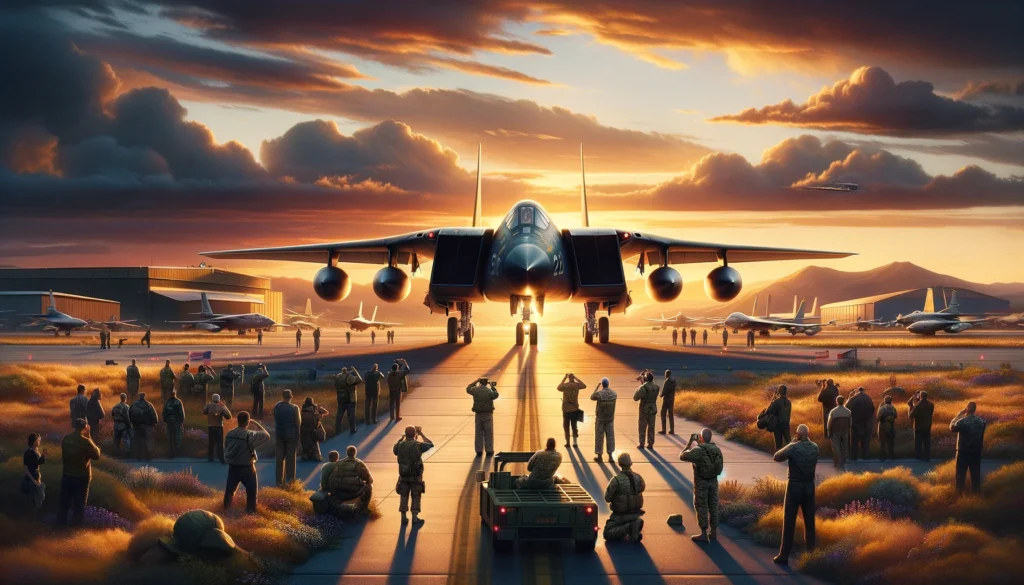
With the sunset of the F-111 Aardvark comes the endurance of its legacy as a symbol of the advancement in air warfare technology by the U.S. Air Force back in the 1960s. Through its one-of-a-kind variable-sweep wing and the way it revolutionized air combat, the F-111 significantly contributed to the books of world aviation.
F-111 was not only a masterpiece of engineering but also a symbol of the endless efforts of engineers to achieve agility and flexibility so that the U.S. could face the upcoming challenges in the Cold War Era. In tactical airpower and precision bombing, there is no substitute for the F-111, as it sets the stage for today’s succeeding generations of aircraft, that gets benefit from its innovative drive.
As part of the U.S. Air Force’s TFX fighter program, the F-111 was designed to meet both the USAF’s need for a deep penetration strike aircraft and the need for a new air-to-air combat fighter by the U.S. Navy.

